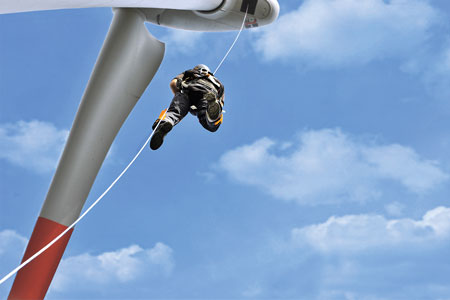Several wind turbine fires have been documented in recent years. Some of them left firefighters helpless as they watched turbine components burn hundreds of feet in the air. Among the most terrible tragedies was one of a maintenance technician killed while working in the hub of the turbine because he had no chance of escaping to the ground. A rescue device could have saved him and the operator was charged for violating safety regulations.
Serious accidents like those illustrated above are one unfortunate part of the huge growth of the U.S. wind power industry, which is one of the world’s largest. The exponential growth of the industry for over 15 years has resulted in a rise in the number of employees. According to the Bureau of Labor Statistics, wind turbine maintenance technician is one of the fastest growing professions nationwide.
Technicians working in this industry usually work several hundred feet above the ground and are exposed to extreme hazards in remote locations. Therefore, it is imperative that they protect themselves against the risk of possibly injury. The U.S. Occupational Safety and Health Administration (OSHA) thus required the use of fall protection equipment, which applies to employees during maintenance and repair work.
Employees of maintenance companies in many cases can only reach the turbine nacelle via a climbing protection system installed inside the tower. This consists of a fixed guide, such as a wire rope or a rail, and a sliding fall arrester that is attached to the full body harness as part of the personal protective system to protect against falling when climbing. As long as the runner is connected to the fixed guide, the user can climb up and down safely. This is just one of the ways the industry has evolved to help protect their employees whilst working at height.
With the ‘Milan’ rescue device, technicians working on wind turbines can abseil quickly in case of emergency. A centrifugal brake allows for safe and secure descend. Credit: SKYLOTEC.
Every Second Counts In an Emergency
When it comes to the safety, employers in the wind industry need to pay even more attention. Wearing appropriate Personal Protective Equipment (PPE) to protect against falling is by no means enough. Employers also have to plan for an emergency, developing procedures for the quickest possible action, which is key since wind turbines are usually located in remote locations.
Rescue services or fire departments cannot always reach the site quickly enough due to geographical restrictions, which is why every employer must ensure that an injured person can be rescued by his or her own colleagues. An example of this could be if a maintenance technician falls due to a trip or a medical problem, such as a dizzy spell or heart attack. If the person in question hangs motionless in a harness, blood circulation is often restricted, which can quickly lead to a life-threatening shock condition, the so-called suspension trauma/intolerance. The person in question often loses consciousness, if the person is left hanging unconscious it may lead to death. This is why every second counts during the rescue.
Storing Rescue Equipment on Site
When rescuing a person from heights, rescue and abseiling devices that are equipped with a centrifugal brake, constant rate descenders, have proven their worth. This allows for a safe free-hand abseil at a controlled speed. Devices like these are usually stored in a sealed system near or at the place of work. Often, they are installed directly at the point of use to ensure accessibility in an emergency.
Having these rescue devices available at the point of work is essential, wind turbines pose additional challenges to technicians every day. If, for example, flammable materials catch on fire due to flying sparks, workers must also be able to get themselves to safety quickly.
“Self-rescue” is also important. In some situations, technicians may have to abseil to the ground on their own, possibly in the event of an evacuation from a hub where access to the rescue device is impossible. In cases such as these, self-evacuation can be done with the help of a personal abseiling device. This is carried directly on the body as a supplement to the PPE and can be used immediately in the case of an emergency. Small and lightweight devices that do not restrict employees are ideal and are becoming more popular within the industry.
Training Is Indispensable and is Legally Required
OSHA requires employers to train employees on proper use of equipment. During training, for example, employees are informed of risks and given basic medical training on how to treat an accident victim. The focus is on practical exercises, which prepare employees for scenarios such as rescuing colleagues. Ideally training can be carried out on site in the actual working environment. Often manufacturers of fall protection devices offer more than just a product portfolio but also training packages tailored specifically to the customer’s needs.
Malcolm Cobb is a lead instructor for wind training at SKYLOTEC. He was formally a lead safety and rescue instructor for one of the industry’s largest manufacturers of wind turbines.














